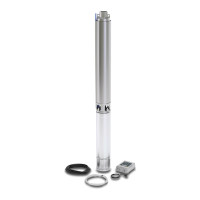ENGLISH
11
12. TROUBLESHOOTING
not start
A. Check that the motor is powered and that the
voltage corresponds to the value on the data plate
B. Check the presence of all phases for three-phase
motors
C. Dry running
B. Restore the missing one
C.
Lower the pump level or wait for the natural
restoration of the level in the well
2. Motor protection is
activated shortly
after starting
A. Make sure that the supply voltage
corresponds to the value on the data plate
B. Check the presence of all phases
C.
Check the setting of the protection and the
presence of possible open or dirty contacts
D. Check that the liquid temperature is not too high
E. Check f
or excessive torque forces (scraping
between rotating and fixed parts, sand in the
pump, etc.)
B. Restore the missing phase
C.
Restore the protections, consulting the data
plate or replacing the components concerned
E.
Eliminate the cause of friction or clean the
pump to remove any obstructions
3. The motor
protection is
tripped after long
periods of
apparently normal
operation
A. Check that the voltage is sufficient and that all the
phases are present
B. Check for
excessive torque forces (scraping
between rotating and fixed parts, presence of
sand, etc.)
A. Restore the missing phase
B.
Eliminate the cause of friction or clean the
pump to remove any obstructions
4. Motor running but
flow rate is not
sufficient
A. In the three-phase versions check the direction of
rotation
B. Check that the pipes are not partially obstructed
C. Check that the pump flow rate is lower than that of
the well
D. Check the state of wear of the pump
A. Invert any two phase leads
B. Eliminate the obstructions
C.
Replace the pump with one with a lower flow
rate
5. Motor running but
pump does not
deliver
A. Check that there has not been an excessive
lowering of the level of the well re
possible dry running
B. Check that the required head is not
that of the pump
C. In the three-
phase versions check the direction of
rotation
D. Pump blocked by impurities
A. Wait for the natural level to be restored or
lower the level of the well. Install adequate
protection against dry running
B. Replace the
pump with one with suitable
characteristics
C. Invert two phase leads
D. Clean the pump, grid or pipes
insufficient
A. Check for leaks in the system
B. In the three-
phase version check the direction of
rotation
C. Check the state of wear of the pump
A. Take action to eliminate leaks
B. Invert two phase leads
7. Pump starts and
stops too
frequently
A. Check for leaks in the system
B. Check the correct operation of the check valve
C. Check the efficiency of the pressure switch, if used
D. Check that the tank is of sufficient size
E. Check the position of the prob
running, if used
A. Take action to eliminate leaks
B. Repair or replace the valve
C. Repair or replace the pressure switch
D. Replace it with one of adequate capacity
E. Reposition the
probes to have longer running
times

